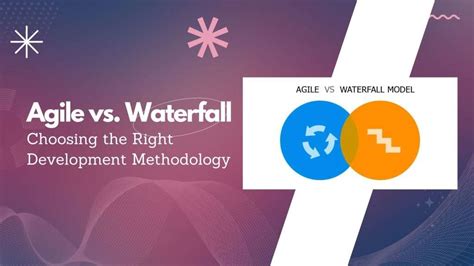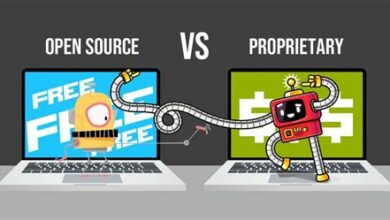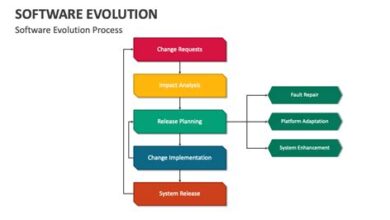Agile vs. Waterfall: Choosing the Right Development Methodology

Choosing the right development methodology is crucial for project success. This post dives into the classic debate of Agile vs. Waterfall, offering a detailed comparison. We’ll explore the fundamental differences between these two approaches, from their iterative nature to their documentation styles. Discover when to leverage the benefits of Agile, understanding its flexibility and collaborative advantages, but also recognizing its potential drawbacks. Finally, we provide actionable steps and key considerations to help you make an informed decision, ensuring your project aligns with the most suitable development methodology for optimal results.
Understanding Software Development Methodologies: A Brief Overview
Software development methodologies are the frameworks that structure, plan, and control the process of developing information systems. Choosing the right methodology is crucial for project success, influencing everything from team collaboration to budget management. The debate of Agile vs. other methodologies is central to this decision, as different approaches suit different project needs and organizational cultures.
Different methodologies offer varying degrees of flexibility, documentation, and customer involvement. Understanding these differences is essential for project managers and stakeholders alike. Some methodologies are highly structured and sequential, while others are iterative and adaptive. The goal is to select a methodology that aligns with the project’s complexity, timeline, and resources.
Common Software Development Methodologies:
- Waterfall
- Agile
- Scrum
- Kanban
- Lean Development
- Spiral Model
Here’s a summary table highlighting a few common software development methodologies:
| Methodology | Approach | Best Suited For |
|---|---|---|
| Waterfall | Sequential, linear process | Projects with clear, fixed requirements |
| Agile | Iterative, incremental process | Projects with evolving requirements |
| Scrum | Agile framework with short iterations (sprints) | Complex projects requiring flexibility |
| Kanban | Visual workflow management system | Continuous improvement and workflow optimization |
Selecting the right methodology involves assessing the project’s unique characteristics and constraints. Factors such as team size, client involvement, and the potential for change all play a role. By carefully evaluating these aspects, organizations can make informed decisions that lead to more efficient and successful software development projects.
Agile vs. Waterfall: A Detailed Comparison Of Key Differences
When comparing Agile vs. Waterfall, it’s crucial to understand that these methodologies represent fundamentally different approaches to software development. Waterfall, the older of the two, follows a sequential, linear process where each phase must be completed before the next one begins. This rigid structure emphasizes detailed planning and documentation upfront. Agile, on the other hand, embraces iterative development, flexibility, and collaboration. Instead of a fixed plan, Agile projects adapt to changing requirements and feedback throughout the development lifecycle.
| Feature | Agile | Waterfall |
|---|---|---|
| Approach | Iterative and incremental | Sequential and linear |
| Flexibility | Highly flexible and adaptable | Limited flexibility |
| Customer Involvement | Continuous customer involvement | Customer involvement at defined stages |
| Change Management | Easily accommodates changes | Resistant to changes after the initial phase |
A key distinction lies in how each methodology handles change. In Waterfall, changes are difficult and costly to implement once a phase is complete. Agile thrives on change, incorporating feedback from stakeholders at each iteration (sprint). This allows for continuous improvement and ensures the final product aligns closely with evolving needs. The emphasis on collaboration in Agile also extends to the development team, fostering a self-organizing and cross-functional environment.
- Project Size: Agile is better suited for small to medium-sized projects, while Waterfall can handle larger projects.
- Requirements Clarity: Waterfall requires clear and stable requirements from the outset, while Agile can accommodate evolving requirements.
- Customer Involvement: Agile requires active customer involvement throughout the project, while Waterfall has limited customer interaction.
- Team Structure: Agile teams are self-organizing and cross-functional, while Waterfall teams are typically hierarchical.
- Risk Management: Agile manages risk through iterative development and continuous feedback, while Waterfall relies on upfront planning.
The impact on project management is significant. Waterfall projects are typically managed using a traditional, top-down approach with detailed project plans and Gantt charts. Agile projects are managed using lightweight frameworks like Scrum or Kanban, focusing on short iterations, daily stand-ups, and continuous delivery. This allows for faster feedback loops and quicker adaptation to changing circumstances. Ultimately, the choice between Agile vs. Waterfall depends on the specific project context, the level of uncertainty, and the desired degree of customer collaboration.
Consider this perspective:
Agile is not just a methodology; it’s a mindset. It’s about embracing change, collaboration, and continuous improvement.
When To Choose Agile: Benefits, Drawbacks, And Practical Applications
The decision to adopt Agile methodologies is not always straightforward. While Agile offers numerous advantages, it’s crucial to understand its suitability for different project types, team sizes, and organizational structures. Assessing whether Agile vs. other methodologies like Waterfall is the right fit involves considering factors such as project complexity, the need for flexibility, and the level of customer involvement required.
| Factor | Agile | Waterfall |
|---|---|---|
| Project Complexity | Well-suited for complex, evolving projects | Best for projects with clear, stable requirements |
| Flexibility | Highly flexible; adapts to changing requirements | Limited flexibility; changes are difficult to implement |
| Customer Involvement | High level of customer collaboration | Customer involvement primarily at the beginning and end |
| Team Size | Works well with small to medium-sized teams | Can accommodate large teams with structured management |
Agile shines when projects require adaptability and continuous improvement. Its iterative nature allows teams to respond quickly to feedback and changing market conditions. However, it’s important to acknowledge the potential drawbacks, such as the need for a highly collaborative team and the possibility of scope creep if not managed effectively. A clear understanding of these trade-offs is essential for successful Agile implementation.
- Benefits of Agile:
- Enhanced Flexibility: Adapts easily to changing requirements.
- Improved Collaboration: Fosters close teamwork and communication.
- Increased Customer Satisfaction: Involves customers throughout the development process.
- Faster Time to Market: Delivers working software in short iterations.
- Higher Quality: Emphasizes continuous testing and improvement.
Before committing to Agile, organizations should evaluate their existing processes, team capabilities, and project goals. A pilot project can be a valuable way to test the waters and identify any potential challenges. Remember that Agile is not a one-size-fits-all solution, and its success depends on careful planning, effective communication, and a commitment to continuous improvement.
Agile for Small Teams
Small teams often find Agile methodologies particularly beneficial due to the inherent flexibility and close collaboration they promote. With fewer team members, communication overhead is reduced, and the iterative nature of Agile allows for rapid adaptation to changing requirements. This can lead to faster development cycles and a more responsive approach to customer feedback. Agile’s emphasis on self-organization empowers small teams to make decisions quickly and efficiently, fostering a sense of ownership and accountability.
Agile for Large Enterprises
Implementing Agile in large enterprises presents unique challenges, but the benefits can be significant. Scaled Agile Frameworks (SAFe) and other scaling methodologies provide a structured approach to coordinating multiple Agile teams working on a large project. These frameworks help align teams with organizational goals, manage dependencies, and ensure consistent delivery. Successful Agile adoption in large enterprises requires strong leadership support, a commitment to cross-functional collaboration, and a willingness to embrace change at all levels of the organization.
Agile in Specific Industries
Agile has found widespread adoption across various industries, including software development, marketing, and even manufacturing. In software development, Agile is particularly well-suited for projects with evolving requirements and a need for rapid iteration. In marketing, Agile methodologies enable teams to quickly adapt to changing market trends and customer preferences. The key to successful Agile implementation in any industry is to tailor the methodology to the specific needs and context of the organization.
Making The Right Choice: Key Considerations And Actionable Steps
Selecting the appropriate development methodology is crucial for the success of any software project. The decision between Agile vs. Waterfall should be based on a careful evaluation of your project’s specific needs, constraints, and goals. This involves understanding the nuances of each methodology and how they align with your organizational culture and client expectations.
One of the initial steps is to assess the clarity of your project requirements. If the requirements are well-defined, stable, and unlikely to change significantly, Waterfall might be a suitable choice. However, if the requirements are expected to evolve or are not fully understood at the outset, Agile methodologies provide the flexibility needed to adapt to changing circumstances. It’s also important to consider the level of client involvement desired throughout the development process. Agile thrives on continuous feedback and collaboration, whereas Waterfall typically involves the client primarily at the beginning and end of the project.
| Consideration | Agile | Waterfall |
|---|---|---|
| Requirement Stability | Handles changing requirements well | Best with well-defined, stable requirements |
| Client Involvement | High, continuous collaboration | Limited, primarily at start and end |
| Project Complexity | Suitable for complex, uncertain projects | Best for simpler, well-understood projects |
| Team Size & Structure | Ideal for smaller, cross-functional teams | Can accommodate larger, more hierarchical teams |
Another critical aspect is the project timeline and budget. Waterfall projects typically have a fixed timeline and budget upfront, which can be advantageous for projects with strict constraints. Agile projects, on the other hand, are more adaptable and can deliver value incrementally, allowing for adjustments to scope and features as needed. This flexibility can be particularly valuable when dealing with uncertainties in the market or evolving user needs.
Steps to Choose the Right Methodology:
- Define Project Goals: Clearly outline what you want to achieve with the project.
- Assess Requirements: Determine how well-defined and stable your requirements are.
- Evaluate Client Involvement: Decide the level of client collaboration needed.
- Consider Team Structure: Assess your team’s size, skills, and communication style.
- Analyze Timeline and Budget: Evaluate your project’s time and cost constraints.
- Weigh the Risks: Identify potential risks and how each methodology can mitigate them.
- Choose the Best Fit: Select the methodology that aligns best with your project’s needs and constraints.
Finally, consider the team’s experience and expertise. If your team is well-versed in Agile practices and has a strong understanding of Agile principles, adopting an Agile methodology may be a smoother transition. Conversely, if your team is more familiar with traditional project management approaches, Waterfall might be a more comfortable starting point. It’s essential to provide adequate training and support to ensure that your team can effectively implement the chosen methodology. Remember that the most successful projects are those where the methodology is not just a process, but a mindset embraced by the entire team.



